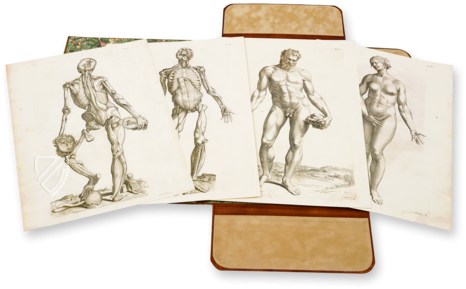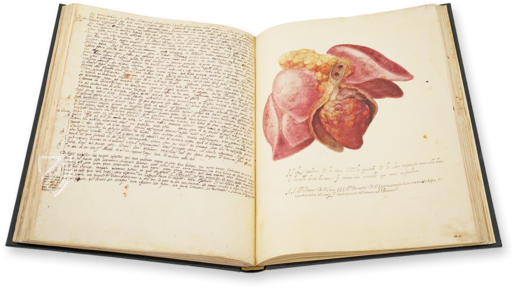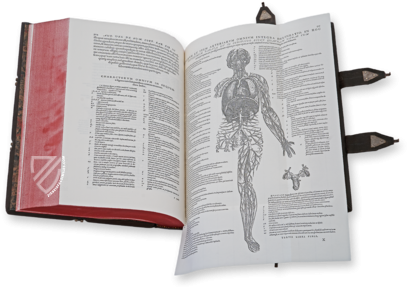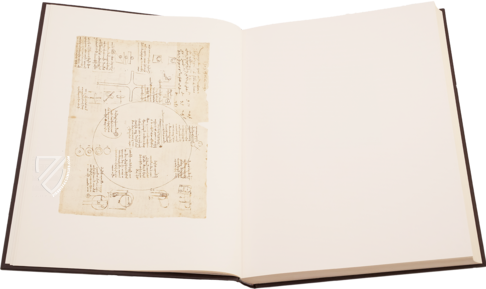Andreas Vesalius: De Humani Corporis Fabrica and Epitome
(3,000€ - 7,000€)
In the mid–16th century, the dissection of human cadavers was considered to be an absolute taboo and was sometimes harshly penalized. Medicinal and anatomical findings were gained from the exploration of animal cadavers. This was not enough for the ambitious medical student Andreas Vesalius. He obtained corpses in adventurous cloak-and-dagger operations from graveyards and used them to conduct his studies, which make up the cornerstone of modern anatomy. Vesalius recorded his findings in his anatomical atlas De humani corporis fabrica and in the abridged Epitome. These medical treatises are two of the most important works on human anatomy to have ever been written and are illustrated with masterful woodcuts.
Andreas Vesalius: De Humani Corporis Fabrica and Epitome
The medical atlas De Humani Corporis Fabrica is the primary work by the anatomist and physician Andreas Vesalius. This series of books is a foundational work of anatomy, which was presented for the first time in history as empirical research on the basis of human cadavers. Before Vesalius, medicinal research was primarily conducted on the bodies of animals. Actually, this extremely comprehensive work consists of seven volumes, however there is also a heavily abbreviated version with the title Epitome. The Epitome consists of 30 woodcuts, which are both of exceptional importance from both an artistic as well as a medical perspective. Andreas Vesalius is considered to be the founder of modern anatomy and left behind an absolute milestone of illumination with his medical treatises, both of which are presented here together in a 1543 print that contains more than 250 masterful woodcuts detailing human anatomy.
The Conservative Anatomy of the Middle Ages
In 16th century France, all medical knowledge taught at the universities and other institutions of higher learning was based on the findings of the 2nd century Roman doctor Claudius Galen. Galen’s numerous medical treatises originate from a time when Roman law forbade the dissection of human bodies. Consequently, Galen managed with the study of animals and extrapolated human anatomy from theirs. Inconsistencies and discrepancies were simply ignored by medieval professors, or explained with quixotic theories. The ambitious and gifted medical student Andreas Vesalius, who began studying anatomy in Paris in 1533, was not satisfied with these insufficient explanations.
Vesalius, a Pioneer of Medicine
Andreas Vesalius was born in Brussels in the year 1514. He was the son of an apothecary and came into contact with medicine at an early age. At the age of 15, he studied the classic subjects of grammar, rhetoric, algebra, and astrology, as well as music, Greek, and Hebrew. At the age of 18, he made his way to Paris in order to study medicine and anatomy. Here, the unusually goal-oriented student was quickly entrusted by his docents and professors with the dissection of cadavers in their lectures. As a result of his observations and experiences, he quickly developed into an expert on human anatomy. In 1537, Vesalius went to Padua, an important center of contemporary anatomy, where he graduated as a medical doctor and on the same day was named professor of surgery. At the young age of 28, Vesalius published his literary magnum opus De Humani Corporis Fabrica. The monumental work in seven large-format volumes with seven hundred pages and almost two hundred illustrations is considered to be a milestone of empirical research. In this book series, Vesalius recorded all of his own findings concerning the human body and in doing so largely deviated from the previous, conservative views of research. A few months later, he published an abridged version with title Epitome. This text became a standard reference for students and physicians.
A Medicinal Masterpiece and Artful Illustration
The success of the Epitome can largely be attributed to the artful woodcuts illustrating the work. The templates thereof probably come partially from Vesalius himself, partially from Jan Stephan van Calcar (ca. 1499–1546), one of the most gifted artists in the workshop of the great painter Titian. The richly detailed, elegant, and often allegorical presentation of the human body appears like a template for the exhibition Body Worlds, which attracted attention to the German doctor and anatomist Gunther von Hagens. Some terms coined by Vesalius survive to today, such as the names hammer and anvil for the auditory ossicles. The significance of Vesalius for medicine has been compared to that of Copernicus for astronomy. With his anatomical atlas, he managed to replace the reigning belief in authority with empiricism and made the dissection of corpses socially acceptable. He additionally became famous due to dramatic stories told about the skill of the physician. Thus, he was rumored to have stolen corpses from graveyards in the dark of night or to have cut them from the gallows and smuggled them through the city. Vesalius has gone down in history as a scholar and adventurer who fought life and limb for his research.
Codicology
- Alternative Titles
- Andreas Vesalius Fabrica und Epitome
- Origin
- Switzerland
- Date
- 1543
- Epochs
- Style
- Illustrations
- More than 250 woodcuts of the different parts of the human body (The Humani Corporis Fabrica); large woodcuts illustrating the dissected body (Epitome)
- Content
- Structure, functionality and pathology of the human body
- Artist / School
- Andreas Vesalius (Andreas van Wezel) (author)
Jan Stephan van Calcar (engraver)
Johannes Oporinus (printer)
Titian workshop
#1 Andreas Vesalius Fabrica and Epitome Set
Languages: English, Japanese
(3,000€ - 7,000€)
- Treatises / Secular Books
- Apocalypses / Beatus
- Astronomy / Astrology
- Bestiaries
- Bibles / Gospels
- Chronicles / History / Law
- Geography / Maps
- Saints' Lives
- Islam / Oriental
- Judaism / Hebrew
- Single Leaf Collections
- Leonardo da Vinci
- Literature / Poetry
- Liturgical Manuscripts
- Medicine / Botany / Alchemy
- Music
- Mythology / Prophecies
- Psalters
- Other Religious Books
- Games / Hunting
- Private Devotion Books
- Other Genres
- Afghanistan
- Armenia
- Austria
- Belgium
- Colombia
- Croatia
- Cyprus
- Czech Republic
- Denmark
- Egypt
- Ethiopia
- France
- Germany
- Greece
- Hungary
- India
- Iran
- Iraq
- Israel
- Italy
- Japan
- Lebanon
- Luxembourg
- Mexico
- Morocco
- Netherlands
- Palestine
- Peru
- Poland
- Portugal
- Russia
- Serbia
- Spain
- Sri Lanka
- Sweden
- Switzerland
- Syria
- Turkey
- Ukraine
- United Kingdom
- United States
- Uzbekistan
- Aboca Museum
- Ajuntament de Valencia
- Akademie Verlag
- Akademische Druck- u. Verlagsanstalt (ADEVA)
- Aldo Ausilio Editore - Bottega d’Erasmo
- Alecto Historical Editions
- Alkuin Verlag
- Almqvist & Wiksell
- Amilcare Pizzi
- Andreas & Andreas Verlagsbuchhandlung
- Archa 90
- Archiv Verlag
- Archivi Edizioni
- Arnold Verlag
- ARS
- Ars Magna
- ArtCodex
- AyN Ediciones
- Azimuth Editions
- Badenia Verlag
- Bärenreiter-Verlag
- Belser Verlag
- Belser Verlag / WK Wertkontor
- Benziger Verlag
- Bernardinum Wydawnictwo
- BiblioGemma
- Biblioteca Apostolica Vaticana (Vaticanstadt, Vaticanstadt)
- Bibliotheca Palatina Faksimile Verlag
- Bibliotheca Rara
- Boydell & Brewer
- Bramante Edizioni
- Bredius Genootschap
- Brepols Publishers
- British Library
- C. Weckesser
- Caixa Catalunya
- Canesi
- CAPSA, Ars Scriptoria
- Caratzas Brothers, Publishers
- Carus Verlag
- Casamassima Libri
- Chavane Verlag
- Christian Brandstätter Verlag
- Circulo Cientifico
- Club Bibliófilo Versol
- Club du Livre
- CM Editores
- Collegium Graphicum
- Collezione Apocrifa Da Vinci
- Comissão Nacional para as Comemorações dos Descobrimentos Portugueses
- Coron Verlag
- Corvina
- CTHS
- D. S. Brewer
- Damon
- De Agostini/UTET
- De Nederlandsche Boekhandel
- De Schutter
- Deuschle & Stemmle
- Deutscher Verlag für Kunstwissenschaft
- DIAMM
- Droz
- E. Schreiber Graphische Kunstanstalten
- Ediciones Boreal
- Ediciones Grial
- Ediclube
- Edições Inapa
- Edilan
- Editalia
- Edition Deuschle
- Edition Georg Popp
- Edition Leipzig
- Edition Libri Illustri
- Editiones Reales Sitios S. L.
- Éditions de l'Oiseau Lyre
- Editions Medicina Rara
- Editorial Casariego
- Editorial Mintzoa
- Editrice Antenore
- Editrice Velar
- Edizioni Edison
- Egeria, S.L.
- Eikon Editores
- Electa
- Emery Walker Limited
- Enciclopèdia Catalana
- Eos-Verlag
- Ephesus Publishing
- Ernst Battenberg
- Eugrammia Press
- Extraordinary Editions
- Fackelverlag
- Facsimila Art & Edition
- Facsimile Editions Ltd.
- Facsimilia Art & Edition Ebert KG
- Faksimile Verlag
- Feuermann Verlag
- Folger Shakespeare Library
- Franco Cosimo Panini Editore
- Friedrich Wittig Verlag
- Fundación Hullera Vasco-Leonesa
- G. Braziller
- Gabriele Mazzotta Editore
- Gebr. Mann Verlag
- Gesellschaft für graphische Industrie
- Getty Research Institute
- Giovanni Domenico de Rossi
- Giunti Editore
- Graffiti
- Grafica European Center of Fine Arts
- Guido Pressler
- Guillermo Blazquez
- Gustav Kiepenheuer
- H. N. Abrams
- Harrassowitz
- Helikon
- Hendrickson Publishers
- Henning Oppermann
- Herder Verlag
- Hes & De Graaf Publishers
- Hoepli
- Holbein-Verlag
- Hortus Deliciarum
- Houghton Library
- Hugo Schmidt Verlag
- Idion Verlag
- Il Bulino, edizioni d'arte
- ILte
- Imago
- Insel Verlag
- Instituto Nacional de Antropología e Historia
- Istituto dell'Enciclopedia Italiana - Treccani
- Istituto Ellenico di Studi Bizantini e Postbizantini
- Istituto Geografico De Agostini
- Istituto Poligrafico e Zecca dello Stato
- Italarte Art Establishments
- J. Thorbecke
- Jan Thorbecke Verlag
- Johnson Reprint Corporation
- Josef Stocker
- Josef Stocker-Schmid
- Jugoslavija
- Karl W. Hiersemann
- Kasper Straube
- Kaydeda Ediciones
- Kindler Verlag / Coron Verlag
- Kodansha International Ltd.
- Konrad Kölbl Verlag
- Kurt Wolff Verlag
- La Liberia dello Stato
- La Linea Editrice
- La Meta Editore
- Lambert Schneider
- Landeskreditbank Baden-Württemberg
- Leo S. Olschki
- Les Incunables
- Library of Congress
- Libreria Musicale Italiana
- Lichtdruck
- Lito Immagine Editore
- Lumen Artis
- Lund Humphries
- M. Moleiro Editor
- Maison des Sciences de l'homme et de la société de Poitiers
- Manuscriptum
- Martinus Nijhoff
- Maruzen-Yushodo Co. Ltd.
- MASA
- McGraw-Hill
- Militos
- Millennium Liber
- Müller & Schindler
- Nahar and Steimatzky
- National Library of Wales
- Neri Pozza
- Nova Charta
- Oceanum Verlag
- Odeon
- Orbis Mediaevalis
- Orbis Pictus
- Österreichische Staatsdruckerei
- Oxford University Press
- Pageant Books
- Parzellers Buchverlag
- Patrimonio Ediciones
- Pattloch Verlag
- PIAF
- Pieper Verlag
- Plon-Nourrit et cie
- Prestel Verlag
- Princeton University Press
- Prisma Verlag
- Priuli & Verlucca, editori
- Pro Sport Verlag
- Propyläen Verlag
- Pytheas Books
- Quaternio Verlag Luzern
- Reales Sitios
- Recht-Verlag
- Reichert Verlag
- Reichsdruckerei
- Riehn & Reusch
- Roberto Vattori Editore
- Rosenkilde and Bagger
- Roxburghe Club
- Salerno Editrice
- Sarajevo Svjetlost
- Schöck ArtPrint Kft.
- Scolar Press
- Scrinium
- Scripta Maneant
- Scriptorium
- Siloé, arte y bibliofilia
- SISMEL - Edizioni del Galluzzo
- Sociedad Mexicana de Antropología
- Société des Bibliophiles & Iconophiles de Belgique
- Soncin Publishing
- Sorli Ediciones
- Stainer and Bell
- Studer
- Styria Verlag
- Sumptibus Pragopress
- Szegedi Tudomànyegyetem
- Taberna Libraria
- Tarshish Books
- Taschen
- Tempus Libri
- Testimonio Compañía Editorial
- Thames and Hudson
- The Clear Vue Publishing Partnership Limited
- The Facsimile Codex
- The Folio Society
- The Marquess of Normanby
- The Richard III and Yorkist History Trust
- Tip.Le.Co
- TouchArt
- TREC Publishing House
- TRI Publishing Co.
- Trident Editore
- Typis Regiae Officinae Polygraphicae
- Union Verlag Berlin
- Universidad de Granada
- University of California Press
- University of Chicago Press
- Urs Graf
- Vallecchi
- Van Wijnen
- VCH, Acta Humaniora
- VDI Verlag
- VEB Deutscher Verlag für Musik
- Verlag Anton Pustet / Andreas Verlag
- Verlag Bibliophile Drucke Josef Stocker
- Verlag der Münchner Drucke
- Verlag für Regionalgeschichte
- Verlag Styria
- Vicent Garcia Editores
- W. Turnowsky
- Waanders Printers
- Wiener Mechitharisten-Congregation (Wien, Österreich)
- Wissenschaftliche Buchgesellschaft
- Wydawnictwo Dolnoslaskie
- Xuntanza Editorial
- Zakład Narodowy
- Zollikofer AG









